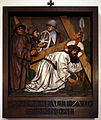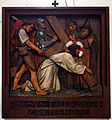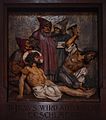St. Adalbero (Würzburg)
St. Adalbero is a Catholic parish church (called Adalberokirche or Sanderau Cathedral ) opened in 1899 , was an expositur from 1905 and has also been a parish in the Würzburg district of Sanderau , which is directly connected to the city center in the south. Together with the St. Andreas Church, it forms the Sanderau parish community and is an outstanding example of neo-Romanesque architecture . The art-historical significance of the Adalberokirche for Würzburg is above all that at the time of construction all sculptors and painters based in Würzburg were involved in the interior design.
history
The Sanderau is the oldest of the residential areas built outside the Ringpark in the course of the 19th century. For a long time, however, there was a lack of a suitable parish church for the growing population.
The Adalberokirche was finally built from 1894 to 1899 based on master drawings by the famous cathedral builder Franz Josef Ritter von Denzinger (among other things responsible for the reconstruction of the Frankfurt Imperial Cathedral and the construction of the Dreikönigskirche ) according to the taste of the time in the historicizing neo- Romanesque style and is dedicated to Saint Adalbero of Würzburg consecrated, who was working as bishop in Würzburg at the time of the investiture dispute . The master builder was the architect Joseph Schmitz , who mainly used Franconian shell limestone. A free-standing basilica in strict neo-Romanesque forms (including a transept , crossing octagon and impressive two-tower facade) was created on a terraced site .
The church was badly damaged by the bombing raid on Würzburg on March 16, 1945 . The altars, the Way of the Cross and other valuable works of art have been preserved. The provisional restoration after 1946 could only be corrected in the 1980s and 1990s as part of an extensive restoration. The crossing tower with its dormers and lantern was restored to its original state. The temporary flat ceilings were removed, new vaults, which corresponded to the original condition, were put in. In the outdoor area, the war damage to the rubble stones could be removed. The church facade was cleaned. In 1992 and 1993 the existing unadorned church windows were replaced by new windows designed artistically by Wladimir Olenburg.
St. Anna Altar
The St. Anna Altar is a joint work of the three brothers Rudolf , Heinz and Matthäus Schiestl . The mosaic picture is by Matthäus, the figure of Saint Anna by Heinz, the angel pictures are by Rudolf Schiestl.
organ
The St. Adalberokirche owned an organ from the company Weise (in Plattling) and has an organ in the north aisle from the Lauffen organ building workshop in Rensch , which was built in 1995. It has 52 registers , which are divided into three manuals . Its massive case is made of spruce and fir, like the windows of the church, the color design of the organ case comes from Vladimir Olenburg. The game table is made of mahogany wood. The Spieltrakturen are mechanically, the Registertrakturen electrically.
|
|
|
|
||||||||||||||||||||||||||||||||||||||||||||||||||||||||||||||||||||||||||||||||||||||||||||||||||||||||||||||||||||||||||||||||||||||||||||||||||||||||||||||||||||||||||||
- Coupling : II / I, III / I, III / II, I / P, II / P, III / P, III 16 '/ P
- Playing aids : electronic setting system , crescendo roller
Bells
After the Second World War, in 1954 the Otto bell foundry in Bremen-Hemelingen cast three bronze bells for the Adalbero Church with the chimes: des' - es' - ges'. The bells have the following diameters: 1500 mm, 1300 mm, 1110 mm, and weigh: 1800 kg, 1250 kg, 780 kg. Together with the bell by Klaus Heidingsfeld from 1930 there are four bells in the towers of the church.
- Adalberoglocke (des ′), Otto / Bremen-Hemelingen bell foundry, cast in 1954
- Our Lady Bell (es ′), Otto / Bremen-Hemelingen bell foundry, cast in 1954
- Josefglocke (ges ′), bell foundry Otto / Bremen-Hemelingen, 1954
- Gertrudis bell (b ′), Klaus Brothers / Heidingsfeld, 1930
It is a minor bell.
Way of the Cross
- Way of the Cross by Heinz Schiestl
Web links
- Parish community Sanderau: Website
- WürzburgWiki: Adalberokirche
- YouTube: The church bells
Individual evidence
- ↑ Klaus Witt City: church and state in the 20th century. In: Ulrich Wagner (Hrsg.): History of the city of Würzburg. 4 volumes, Volume I-III / 2, Theiss, Stuttgart 2001-2007; III / 1–2: From the transition to Bavaria to the 21st century. 2007, ISBN 978-3-8062-1478-9 , pp. 453–478 and 1304 f., Here: pp. 455–458: The Church Development under Bishop Ferdinand Schlör (1898–1924). P. 455 f.
- ↑ Klaus lens Meyer: The organs in Wurzburg churches. In: Josef Brecht, Gerhart Gradenegger (ed.): Friedrich-Koenig-Gymnasium Würzburg. Annual report 1979/80. Edited by the directorate of the Friedrich-Koenig-Gymnasium Würzburg. Würzburg 1980, pp. 112–120 ( Würzburg and his “Organ Landscape” ), pp. 117–119, here: p. 119.
- ↑ More information on the municipality's website; available on the website of the builder company
- ^ Gerhard Reinhold: Otto bells. Family and company history of the Otto bell foundry dynasty . Self-published, Essen 2019, ISBN 978-3-00-063109-2 , p. 588, especially pages .
- ↑ Gerhard Reinhold: Church bells - Christian world cultural heritage, illustrated using the example of the bell founder Otto, Hemelingen / Bremen . Nijmegen / NL 2019, p. 556 , urn : nbn: nl: ui: 22-2066 / 204770 (dissertation at Radboud Universiteit Nijmegen).
- ^ Thomas Wehner (author): Real Schematism of the Diocese of Würzburg. Deanery Würzburg-Stadt 1992, p. 45
Coordinates: 49 ° 47 ′ 3 ″ N , 9 ° 56 ′ 10 ″ E


















